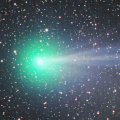
|
It returns for the first time in 70 years. Now it is 5.2 mag (Mar. 21, Yoshimi Nagai). It brightens up to 4.5 mag, but it will turn to fade out rapidly after that. In the Northern Hemisphere, it will be unobservable in April. In the Southern Hemisphere, it is not observable now, but it will appear in April.
Date(TT) R.A. (2000) Decl. Delta r Elong. m1 Best Time(A, h)
Mar. 23 1 28.33 27 55.1 1.619 0.951 32 5.4 19:38 (115, 13)
Mar. 30 2 0.44 24 12.8 1.612 0.885 29 5.1 19:45 (112, 11)
|

|
Now it is 9.6 mag (Mar. 15, Thomas Lehmann). Fading gradually. In the Northern Hemisphere, it stays observable in good condition. In the Southern Hemisphere, it will be unobservable in May.
Date(TT) R.A. (2000) Decl. Delta r Elong. m1 Best Time(A, h)
Mar. 23 19 7.94 14 2.3 1.307 1.432 75 9.2 4:34 (292, 50)
Mar. 30 19 23.86 20 7.9 1.329 1.474 77 9.3 4:24 (285, 54)
|
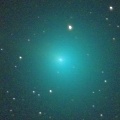
|
Now it is 10.1 mag (Mar. 12, Chris Wyatt). It will fade out rapidly after this. It will be fainter than 18 mag in July. It stays observable in good condition.
Date(TT) R.A. (2000) Decl. Delta r Elong. m1 Best Time(A, h)
Mar. 23 6 42.10 17 27.8 1.056 1.544 97 11.1 19:38 ( 41, 68)
Mar. 30 7 3.15 17 10.1 1.128 1.579 95 11.4 19:45 ( 47, 66)
|
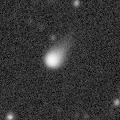
|
It will approach to Sun down to 0.4 a.u. in late September, and it is expected to brighten up to 0 mag. Now it is 11.2 mag (Mar. 19, Osamu Miyazaki). It will brighten rapidly after this. It stays observable in good condition. At the high light, in the Northern Hemisphere, it will be observable in good condition after the perihelion passage. In the Southern Hemisphere, it will be observable in the low sky before and after the perihelion passage.
Date(TT) R.A. (2000) Decl. Delta r Elong. m1 Best Time(A, h)
Mar. 23 14 46.15 -5 53.9 2.443 3.274 140 11.6 2:44 ( 0, 49)
Mar. 30 14 35.85 -5 12.4 2.283 3.186 149 11.3 2:07 ( 0, 50)
|
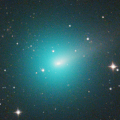
|
It brightened up to 7.4 mag from December to January (Dec. 24, Osamu Miyazaki). Now it is 11.0 mag (Mar. 19, Osamu Miyazaki). Fading rapidly. It will be fainter than 18 mag in June. It stays observable in good condition.
Date(TT) R.A. (2000) Decl. Delta r Elong. m1 Best Time(A, h)
Mar. 23 12 17.87 10 12.8 0.643 1.632 168 11.4 0:16 ( 0, 65)
Mar. 30 12 12.42 9 53.2 0.695 1.681 165 12.0 23:39 ( 0, 65)
|
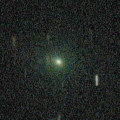
|
It returned for the first time in 68 years. It will brighten up to 7.5 mag in summer. Now it is 11.4 mag (Mar. 15, Osamu Miyazaki). It will brighten rapidly after this. It locates somewhat low in the Northern Hemisphere. In the Southern Hemisphere, it will be unobservable in May. At the high light, it locates low in the Northern Hemisphere, or it is not observable in the Southern Hemisphere.
Date(TT) R.A. (2000) Decl. Delta r Elong. m1 Best Time(A, h)
Mar. 23 3 28.29 12 5.6 2.323 1.857 50 12.2 19:38 ( 85, 29)
Mar. 30 3 38.05 14 39.5 2.320 1.785 46 11.9 19:45 ( 91, 25)
|
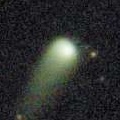
|
Now it is 12.2 mag (Mar. 13, Osamu Miyazaki). It stays 13 mag for a while. It will be unobservable in May in the Southern Hemisphere, or in June in the Northern Hemisphere. But it will be observable again in July in the Northern Hemisphere.
Date(TT) R.A. (2000) Decl. Delta r Elong. m1 Best Time(A, h)
Mar. 23 7 6.78 29 8.8 3.657 3.985 102 12.5 19:38 ( 55, 80)
Mar. 30 7 1.11 29 53.7 3.767 3.962 93 12.6 19:45 ( 78, 73)
|
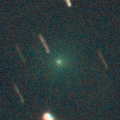
|
First return of a new periodic comet which brightened up to 10 mag in 2001. Now it is 12.8 mag (Mar. 1, Alan Hale). It will fade out rapidly after this. It will be fainter than 18 mag in June. It locates somewhat low in the Northern Hemisphere. In the Southern Hemisphere, it will never be observable after this.
Date(TT) R.A. (2000) Decl. Delta r Elong. m1 Best Time(A, h)
Mar. 23 1 12.19 44 11.8 1.960 1.446 45 13.1 19:38 (132, 19)
Mar. 30 1 32.76 48 15.0 1.972 1.470 46 13.3 19:45 (137, 19)
|

|
The condition is bad in this apparition. It brightens up to 10 mag in early summer, however, it is not observable at all. Brightening gradually. It will never be observable after this.
Date(TT) R.A. (2000) Decl. Delta r Elong. m1 Best Time(A, h)
Mar. 23 0 56.80 -0 20.4 2.255 1.296 11 13.6 19:38 ( 96, -9)
Mar. 30 1 18.43 2 23.4 2.213 1.247 10 13.1 19:45 (101,-10)
|

|
Now it is 13.7 mag (Mar. 5, Thomas Lehmann). Fading slowly. In the Northern Hemisphere, it will be unobservable in June. In the Southern Hemisphere, it stays observable in good condition.
Date(TT) R.A. (2000) Decl. Delta r Elong. m1 Best Time(A, h)
Mar. 23 13 34.29 -38 6.6 1.870 2.695 138 13.5 1:34 ( 0, 17)
Mar. 30 13 2.54 -38 54.3 1.825 2.699 144 13.5 0:35 ( 0, 16)
|

|
It was observed at 9-10 mag for a long time in 2023. Now it is 13.1 mag (Mar. 5, Chris Wyatt). It stays 14 mag for a while. In the Northern Hemisphere, it will never be observable after this. In the Southern Hemisphere, it will be getting higher gradually.
Date(TT) R.A. (2000) Decl. Delta r Elong. m1 Best Time(A, h)
Mar. 23 23 59.81 -39 57.3 4.789 4.090 41 13.5 4:34 (297,-36)
Mar. 30 0 4.58 -40 19.1 4.798 4.147 44 13.6 4:24 (298,-34)
|

|
Now it is 12.8 mag (Mar. 9, Toshihiko Ikemura, Hirohisa Sato). It will be getting lower gradually after this, and it will be unobservable in July.
Date(TT) R.A. (2000) Decl. Delta r Elong. m1 Best Time(A, h)
Mar. 23 8 4.04 21 22.6 5.684 6.188 116 13.7 19:59 ( 0, 76)
Mar. 30 8 3.90 21 17.2 5.789 6.190 109 13.8 19:45 ( 13, 76)
|

|
Now it is 13.7 mag (Mar. 7, Chris Wyatt). It stays 14 mag for a while. It locates somewhat low in the Northern Hemisphere. But it will become high in winter. In the Southern Hemisphere, it stays observable in good condition.
Date(TT) R.A. (2000) Decl. Delta r Elong. m1 Best Time(A, h)
Mar. 23 12 3.03 -36 49.7 4.310 5.151 144 13.8 0:01 ( 0, 18)
Mar. 30 12 0.44 -36 0.3 4.273 5.138 146 13.8 23:27 ( 0, 19)
|
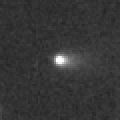
|
It is expected to brighten up to 12 mag in early summer. Now it is 13.5 mag (Mar. 7, Thomas Lehmann). Brightening slowly. It stays extremely low in the Northern Hemisphere. But it will become high in summer. In the Southern Hemisphere, it will be unobservable in April. At the high light, it is not observable in the Southern Hemisphere, or it locates low in the Northern Hemisphere.
Date(TT) R.A. (2000) Decl. Delta r Elong. m1 Best Time(A, h)
Mar. 23 2 35.37 6 37.3 2.232 1.554 36 14.2 19:38 ( 88, 15)
Mar. 30 2 43.73 10 30.9 2.222 1.483 32 14.0 19:45 ( 95, 12)
|

|
It brightened up to 8 mag from 2022 summer to 2023 spring. Now it is 13.8 mag (Mar. 12, Chris Wyatt). Fading slowly. It will be getting lower gradually after this, and it will be unobservable in May. But it will be observable again in July in the Southern Hemisphere.
Date(TT) R.A. (2000) Decl. Delta r Elong. m1 Best Time(A, h)
Mar. 23 5 8.50 8 30.7 5.502 5.328 74 14.1 19:38 ( 63, 46)
Mar. 30 5 10.37 9 16.0 5.672 5.388 68 14.2 19:45 ( 70, 40)
|
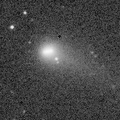
|
Now it is 14.1 mag (Mar. 12, Chris Wyatt). Fading slowly. It will be unobservable in July.
Date(TT) R.A. (2000) Decl. Delta r Elong. m1 Best Time(A, h)
Mar. 23 4 27.95 28 0.9 2.206 2.041 67 14.1 19:38 ( 94, 49)
Mar. 30 4 43.70 28 40.3 2.263 2.034 63 14.1 19:45 ( 97, 45)
|
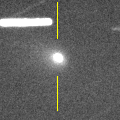
|
Now it is 13.8 mag (Mar. 14, Thomas Lehmann). Fading rapidly. It will be fainter than 18 mag in May. It stays observable in good condition. Vladimir Bezugly reported it was visible at around 12 mag in the SWAN images in late January.
Date(TT) R.A. (2000) Decl. Delta r Elong. m1 Best Time(A, h)
Mar. 23 8 54.62 -1 41.2 0.294 1.211 131 14.2 20:53 ( 0, 53)
Mar. 30 9 36.21 1 7.4 0.355 1.275 135 14.8 21:06 ( 0, 56)
|

|
First return of a new periodic comet which was discovered in 2011, half a year after the perihelion passage. Now it is 14.5 mag (Mar. 10, Toshihiko Ikemura, Hirohisa Sato). Fading slowly. In the Northern Hemisphere, it will be getting lower gradually. In the Southern Hemisphere, it stays observable in good condition.
Date(TT) R.A. (2000) Decl. Delta r Elong. m1 Best Time(A, h)
Mar. 23 7 42.46 -3 19.7 0.629 1.373 113 14.4 19:38 ( 0, 51)
Mar. 30 7 47.17 -5 17.4 0.628 1.337 108 14.2 19:45 ( 11, 49)
|

|
Now it is 14.3 mag (Mar. 15, ATLAS Chile). Fading slowly. In the Northern Hemisphere, it will be unobservable in May. In the Southern Hemisphere, it stays observable in good condition.
Date(TT) R.A. (2000) Decl. Delta r Elong. m1 Best Time(A, h)
Mar. 23 7 40.53 -41 1.7 4.410 4.808 107 14.3 19:38 ( 1, 14)
Mar. 30 7 34.31 -39 52.6 4.510 4.846 103 14.4 19:45 ( 9, 14)
|

|
Brightening rapidly. Now it is not observable. It will appear in April in the Southern Hemisphere, or in May in the Northern Hemisphere. It brightens up to 11.5 mag in early summer. But it locates very low around the high light.
Date(TT) R.A. (2000) Decl. Delta r Elong. m1 Best Time(A, h)
Mar. 23 23 20.70 -4 28.9 2.760 1.804 13 15.0 4:34 (267,-11)
Mar. 30 23 36.98 -1 59.3 2.709 1.767 15 14.5 4:24 (265,-10)
|

|
It brightened up to 8.3 mag in 2021-2022 winter (Jan. 6, 2022, Toshiyuki Takahashi). Now it is 13.7 mag (Mar. 7, Thomas Lehmann). It stays 15 mag for a while. In the Northern Hemisphere, it will be unobservable in May. In the Southern Hemisphere, it stays observable in good condition.
Date(TT) R.A. (2000) Decl. Delta r Elong. m1 Best Time(A, h)
Mar. 23 10 50.94 -53 47.3 6.946 7.559 124 14.6 22:45 ( 0, 1)
Mar. 30 10 47.11 -53 28.5 6.979 7.604 125 14.6 22:14 ( 0, 1)
|

|
It brightened up to 7.8 mag in late July in 2023 (July 20, 2023, Thomas Lehmann). Now it is 16.5 mag (Mar. 18, ATLAS Chile). Fading gradually. It stays observable in good condition.
Date(TT) R.A. (2000) Decl. Delta r Elong. m1 Best Time(A, h)
Mar. 23 13 42.53 15 43.1 2.429 3.339 151 14.7 1:41 ( 0, 71)
Mar. 30 13 26.59 17 38.6 2.477 3.409 155 14.8 0:58 ( 0, 72)
|
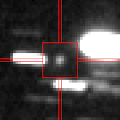
|
It is expected to brighten up to 12.5 mag in summer. Now it is 15.2 mag (Mar. 16, Thomas Lehmann). Brightening slowly. In the Northern Hemisphere, it is not observable now. In the Southern Hemisphere, it stays observable in good condition. Around the high light, it is observable in good condition in the Southern Hemisphere, but it locates very low in the Northern Hemisphere.
Date(TT) R.A. (2000) Decl. Delta r Elong. m1 Best Time(A, h)
Mar. 23 16 39.09 -73 0.9 3.219 3.490 97 15.0 4:34 ( 0,-18)
Mar. 30 16 47.68 -74 1.1 3.109 3.438 100 14.8 4:19 ( 0,-19)
|
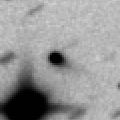
|
Now it is 14.7 mag (Mar. 9, Toshihiko Ikemura, Hirohisa Sato). It will fade out rapidly after this. It will be fainter than 18 mag in June. In the Northern Hemisphere, it stays observable in good condition.
Date(TT) R.A. (2000) Decl. Delta r Elong. m1 Best Time(A, h)
Mar. 23 8 7.83 32 19.7 0.945 1.630 114 15.0 20:04 ( 0, 87)
Mar. 30 8 20.79 30 43.7 0.995 1.638 110 15.1 19:49 ( 0, 86)
|
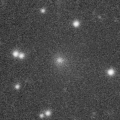
|
Now it is 15.9 mag (Mar. 10, Jean-Claude Merlin). It will fade out rapidly after this. It will be fainter than 18 mag in June. In the Northern Hemisphere, it stays observable in good condition. In the Southern Hemisphere, it will be getting lower gradually.
Date(TT) R.A. (2000) Decl. Delta r Elong. m1 Best Time(A, h)
Mar. 23 16 59.66 -23 22.2 1.063 1.649 106 15.3 4:34 (354, 31)
Mar. 30 16 52.26 -16 7.6 1.003 1.694 115 15.3 4:23 ( 0, 39)
|
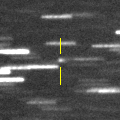
|
Now it is 16.1 mag (Mar. 14, ATLAS Chile). Fading gradually. It will be fainter than 18 mag in July. It stays observable in good condition.
Date(TT) R.A. (2000) Decl. Delta r Elong. m1 Best Time(A, h)
Mar. 23 19 18.59 -11 54.2 1.489 1.535 73 15.5 4:34 (313, 30)
Mar. 30 19 37.56 -11 1.8 1.456 1.543 75 15.5 4:24 (312, 30)
|

|
It brightened up to 12.1 mag in 2023 spring (May 20, 2023, Jose Guilherme de S. Aguiar). Now it is 15.1 mag (Mar. 12, Chris Wyatt). Fading slowly. In the Northern Hemisphere, it is not observable now. In the Southern Hemisphere, it stays observable in good condition.
Date(TT) R.A. (2000) Decl. Delta r Elong. m1 Best Time(A, h)
Mar. 23 4 29.93 -55 5.7 4.426 4.311 76 15.5 19:38 ( 26, -9)
Mar. 30 4 37.41 -52 56.4 4.488 4.355 75 15.6 19:45 ( 30,-10)
|

|
Now it is 16.5 mag (Mar. 18, ATLAS Chile). It stays 16 mag for a while. It stays observable in good condition.
Date(TT) R.A. (2000) Decl. Delta r Elong. m1 Best Time(A, h)
Mar. 23 13 5.57 3 44.9 2.610 3.583 165 15.6 1:04 ( 0, 59)
Mar. 30 13 0.98 4 9.2 2.580 3.567 169 15.5 0:32 ( 0, 59)
|
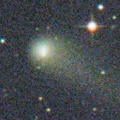
|
It brightened up to 11.1 mag in early 2022 (Mar. 31, 2022, F. Kugel, J.-G. Bosch, J. Nicolas). Now it is 15.6 mag (Mar. 15, ATLAS-MLO, Mauna Loa). It stays 16 mag for a while. In the Northern Hemisphere, it stays observable in good condition. It locates somewhat low in the Southern Hemisphere.
Date(TT) R.A. (2000) Decl. Delta r Elong. m1 Best Time(A, h)
Mar. 23 17 46.35 25 22.1 6.538 6.694 94 15.6 4:34 (298, 72)
Mar. 30 17 47.38 26 17.9 6.507 6.734 98 15.7 4:24 (304, 76)
|
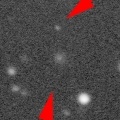
|
It is expected to brighten up to 11.5 mag in 2025 autumn, and it will be observable in good condition. Brightening slowly. It locates somewhat low in the Northern Hemisphere. But it will become high in summer. In the Southern Hemisphere, it will be getting higher gradually.
Date(TT) R.A. (2000) Decl. Delta r Elong. m1 Best Time(A, h)
Mar. 23 22 10.83 -10 43.4 6.499 5.675 31 15.9 4:34 (282, -1)
Mar. 30 22 16.26 -10 9.4 6.398 5.634 37 15.8 4:24 (284, 2)
|

|
Now it is 15.6 mag (Mar. 10, Toshihiko Ikemura, Hirohisa Sato). It stays 16 mag for a while. It will be unobservable in May in the Northern Hemisphere, or in June in the Southern Hemisphere. But it will be observable again in June in the Southern Hemisphere.
Date(TT) R.A. (2000) Decl. Delta r Elong. m1 Best Time(A, h)
Mar. 23 4 38.22 -4 5.8 7.031 6.711 67 15.8 19:38 ( 58, 32)
Mar. 30 4 41.30 -3 24.6 7.093 6.683 62 15.8 19:45 ( 65, 27)
|
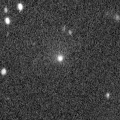
|
Very large comet. It is expected to brighten up to 13 mag in 2031. Now it is 15.3 mag (Mar. 4, Thomas Lehmann). It stays 16 mag for a while. In the Northern Hemisphere, it is not observable now. In the Northern Hemisphere, it is not observable until 2030.
Date(TT) R.A. (2000) Decl. Delta r Elong. m1 Best Time(A, h)
Mar. 23 3 4.36 -62 6.2 16.857 16.563 71 15.8 19:38 ( 28,-22)
Mar. 30 3 7.39 -61 53.7 16.823 16.538 71 15.8 19:45 ( 31,-25)
|
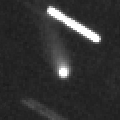
|
Now it is 16.1 mag (Feb. 22, ATLAS Chile). It stays 15 mag for a while. In the Northern Hemisphere, it is not observable now. It locates somewhat low in the Southern Hemisphere. But it will become high in summer. The brightness evolution is slower than originally expected.
Date(TT) R.A. (2000) Decl. Delta r Elong. m1 Best Time(A, h)
Mar. 23 2 11.03 -31 18.2 3.661 3.015 43 15.9 19:38 ( 60,-12)
Mar. 30 2 18.05 -31 37.3 3.638 2.987 43 15.8 19:45 ( 63,-17)
|

|
It approached to Earth down to 0.38 a.u., and brightened up to 8.0 mag in last autumn (Sept. 29, Virgilio Gonano). Now it is 16.1 mag (Mar. 10, Toshihiko Ikemura, Hirohisa Sato). It will fade out rapidly after this. It will be fainter than 18 mag in May. It stays observable in good condition.
Date(TT) R.A. (2000) Decl. Delta r Elong. m1 Best Time(A, h)
Mar. 23 8 8.79 0 53.4 1.551 2.222 119 15.9 20:04 ( 0, 56)
Mar. 30 8 13.93 1 47.9 1.677 2.281 114 16.2 19:45 ( 1, 57)
|
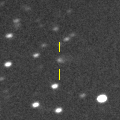
|
Now it is 16.9 mag (Mar. 17, ATLAS Chile). It stays 17 mag for a while. It locates somewhat low in the Northern Hemisphere. But it will become high in summer. In the Southern Hemisphere, it stays observable in good condition.
Date(TT) R.A. (2000) Decl. Delta r Elong. m1 Best Time(A, h)
Mar. 23 14 15.57 -28 8.7 2.642 3.460 139 16.2 2:14 ( 0, 27)
Mar. 30 14 14.78 -27 38.9 2.591 3.466 146 16.2 1:45 ( 0, 27)
|

|
It will brighten up to 15 mag from summer to autumn. Now it is 15.2 mag (Mar. 18, E. Cortes). Brightening slowly. In the Northern Hemisphere, it will be unobservable in April. In the Southern Hemisphere, it will be getting higher gradually.
Date(TT) R.A. (2000) Decl. Delta r Elong. m1 Best Time(A, h)
Mar. 23 21 52.96 -16 42.4 2.514 1.834 37 16.5 4:34 (290, -1)
Mar. 30 22 10.98 -15 18.8 2.471 1.828 40 16.4 4:24 (289, 0)
|

|
It brightened up to 13 mag in early 2023. It stays 17 mag for a while. It stays extremely low in the Northern Hemisphere. In the Southern Hemisphere, it stays observable in good condition.
Date(TT) R.A. (2000) Decl. Delta r Elong. m1 Best Time(A, h)
Mar. 23 16 31.59 -47 12.5 3.745 4.149 107 16.5 4:30 ( 0, 8)
Mar. 30 16 27.38 -46 53.3 3.702 4.209 114 16.5 3:58 ( 0, 8)
|
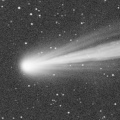
|
It approached to Sun down to 0.23 a.u. and brightened up to 2.5 mag in mid September in 2023 (Sept. 18, 2023, Juan Jose Gonzalez). Now it is 16.6 mag (Mar. 15, Thomas Lehmann). Fading gradually. It will be fainter than 18 mag in May. It stays extremely low in the Northern Hemisphere. In the Southern Hemisphere, it stays observable in good condition.
Date(TT) R.A. (2000) Decl. Delta r Elong. m1 Best Time(A, h)
Mar. 23 8 18.78 -43 53.5 2.845 3.368 113 16.5 20:13 ( 0, 11)
Mar. 30 8 13.52 -41 28.4 2.973 3.456 110 16.8 19:45 ( 1, 14)
|
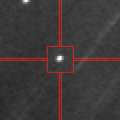
|
Now it is 16.9 mag (Mar. 15, ATLAS Chile). Fading slowly. It will be fainter than 18 mag in July. It will be unobservable in May in the Northern Hemisphere, or in June in the Southern Hemisphere.
Date(TT) R.A. (2000) Decl. Delta r Elong. m1 Best Time(A, h)
Mar. 23 5 33.73 -51 35.8 1.742 1.934 85 16.6 19:38 ( 20, -1)
Mar. 30 5 32.55 -44 9.1 1.788 1.916 81 16.6 19:45 ( 29, 3)
|
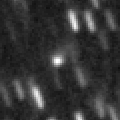
|
Now it is 17.1 mag (Mar. 19, ATLAS Chile). It stays 17 mag for a while. In the Northern Hemisphere, it will be unobservable in July. In the Southern Hemisphere, it stays observable in good condition.
Date(TT) R.A. (2000) Decl. Delta r Elong. m1 Best Time(A, h)
Mar. 23 16 36.32 -49 44.4 5.360 5.709 105 16.7 4:34 ( 0, 5)
Mar. 30 16 28.79 -50 28.2 5.231 5.688 112 16.6 4:00 ( 0, 4)
|
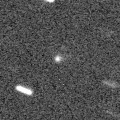
|
Now it is 16.7 mag (Mar. 2, Toshihiko Ikemura, Hirohisa Sato). It stays 16 mag for a while. It will be unobservable in May.
Date(TT) R.A. (2000) Decl. Delta r Elong. m1 Best Time(A, h)
Mar. 23 2 59.40 11 42.2 2.843 2.229 43 16.8 19:38 ( 89, 23)
Mar. 30 3 12.15 12 52.4 2.866 2.196 39 16.7 19:45 ( 93, 19)
|
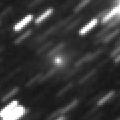
|
Very far object. Now it is 17.1 mag (Feb. 28, ATLAS Chile). It stays 17 mag for a while. In the Northern Hemisphere, it is not observable now.
Date(TT) R.A. (2000) Decl. Delta r Elong. m1 Best Time(A, h)
Mar. 23 2 20.18 -65 44.0 10.622 10.336 70 16.8 19:38 ( 28,-28)
Mar. 30 2 23.04 -65 10.6 10.608 10.338 71 16.8 19:45 ( 29,-31)
|
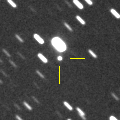
|
Now it is 16.5 mag (Mar. 15, Yukihiro Sugiyama). Fading slowly. It will be fainter than 18 mag in May. It stays observable in good condition.
Date(TT) R.A. (2000) Decl. Delta r Elong. m1 Best Time(A, h)
Mar. 23 8 41.59 -16 24.9 0.960 1.749 126 16.8 20:37 ( 0, 39)
Mar. 30 8 46.76 -16 6.7 1.000 1.754 122 17.0 20:14 ( 0, 39)
|
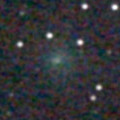
|
It must have brightened up to 11 mag in winter. However, it was too low to observe at the high light. Now it is 16.1 mag (Mar. 17, ATLAS Chile). Fading rapidly. It will be fainter than 18 mag in April. It stays observable in good condition.
Date(TT) R.A. (2000) Decl. Delta r Elong. m1 Best Time(A, h)
Mar. 23 18 37.76 -22 24.4 1.078 1.387 83 16.9 4:34 (329, 26)
Mar. 30 18 8.28 -18 21.2 0.967 1.477 97 17.5 4:24 (338, 34)
|
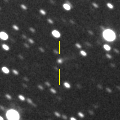
|
Now it is 17.2 mag (Mar. 2, Toshihiko Ikemura, Hirohisa Sato). It stays 17 mag for a while. It will be unobservable in May.
Date(TT) R.A. (2000) Decl. Delta r Elong. m1 Best Time(A, h)
Mar. 23 4 54.72 26 34.1 5.128 4.928 72 16.9 19:38 ( 89, 53)
Mar. 30 4 59.91 26 9.2 5.219 4.918 67 17.0 19:45 ( 92, 47)
|
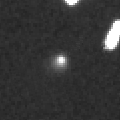
|
Now it is 16.7 mag (Mar. 16, ATLAS Chile). It stays 17 mag for a while. In the Northern Hemisphere, it will be unobservable in April. In the Southern Hemisphere, it stays observable in good condition.
Date(TT) R.A. (2000) Decl. Delta r Elong. m1 Best Time(A, h)
Mar. 23 4 55.97 -31 24.8 7.622 7.427 74 17.0 19:38 ( 36, 13)
Mar. 30 4 59.24 -30 34.8 7.658 7.405 71 17.0 19:45 ( 42, 10)
|
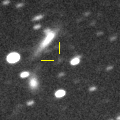
|
Now it is 16.6 mag (Mar. 9, Toshihiko Ikemura, Hirohisa Sato). It stays 17 mag for a while. It locates somewhat low in the Northern Hemisphere. In the Southern Hemisphere, it stays observable in good condition.
Date(TT) R.A. (2000) Decl. Delta r Elong. m1 Best Time(A, h)
Mar. 23 16 2.17 -29 46.3 2.573 3.162 117 17.1 4:00 ( 0, 25)
Mar. 30 16 3.35 -29 53.3 2.488 3.160 124 17.0 3:34 ( 0, 25)
|
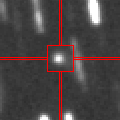
|
Now it is 16.6 mag (Mar. 9, Toshihiko Ikemura, Hirohisa Sato). It stays 17 mag for a while. In the Northern Hemisphere, it will be getting lower gradually after this, and it will be unobservable in June. In the Southern Hemisphere, it stays observable in good condition.
Date(TT) R.A. (2000) Decl. Delta r Elong. m1 Best Time(A, h)
Mar. 23 7 42.77 -7 37.7 3.999 4.487 113 17.2 19:38 ( 0, 47)
Mar. 30 7 43.69 -7 14.3 4.046 4.451 107 17.2 19:45 ( 12, 47)
|

|
Now it is 16.9 mag (Mar. 2, Toshihiko Ikemura, Hirohisa Sato). It stays 17 mag for a while. It stays observable in good condition.
Date(TT) R.A. (2000) Decl. Delta r Elong. m1 Best Time(A, h)
Mar. 23 10 27.62 10 39.8 4.809 5.710 152 17.3 22:22 ( 0, 66)
Mar. 30 10 23.48 11 49.7 4.837 5.675 143 17.2 21:50 ( 0, 67)
|

|
Now it is 17.0 mag (Mar. 2, ATLAS-HKO, Haleakala). It stays 17 mag for a while. It will be unobservable in April in the Southern Hemisphere, or in June in the Northern Hemisphere. But it will be observable again in July in the Northern Hemisphere.
Date(TT) R.A. (2000) Decl. Delta r Elong. m1 Best Time(A, h)
Mar. 23 4 48.93 39 11.8 6.917 6.710 73 17.2 19:38 (110, 55)
Mar. 30 4 53.42 39 5.3 7.021 6.713 68 17.3 19:45 (111, 50)
|

|
Now it is 17.8 mag (Mar. 16, ATLAS South Africa). It stays 17 mag for a while. In the Northern Hemisphere, it will be unobservable in April. In the Southern Hemisphere, it stays observable in good condition. It stays 15 mag for a long time from late 2024 to early 2026.
Date(TT) R.A. (2000) Decl. Delta r Elong. m1 Best Time(A, h)
Mar. 23 6 2.15 -50 2.9 5.331 5.417 89 17.5 19:38 ( 16, 2)
Mar. 30 6 3.60 -48 10.7 5.326 5.378 87 17.4 19:45 ( 22, 2)
|

|
It stays 17 mag for a while. It stays observable in good condition.
Date(TT) R.A. (2000) Decl. Delta r Elong. m1 Best Time(A, h)
Mar. 23 15 34.47 -9 49.3 2.212 2.936 128 17.6 3:32 ( 0, 45)
Mar. 30 15 34.92 -9 0.5 2.136 2.928 134 17.5 3:05 ( 0, 46)
|
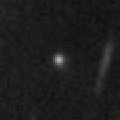
|
It will brighten up to 14 mag from summer to autumn. Now it is 18.2 mag (Mar. 17, ATLAS Chile). Brightening gradually. It stays observable in good condition. Around the high light, it is observable in good condition in the Southern Hemisphere. But it locates extremely low in the Northern Hemisphere.
Date(TT) R.A. (2000) Decl. Delta r Elong. m1 Best Time(A, h)
Mar. 23 13 13.42 -21 39.9 1.505 2.441 154 17.8 1:12 ( 0, 33)
Mar. 30 13 7.62 -21 46.5 1.436 2.400 160 17.5 0:39 ( 0, 33)
|
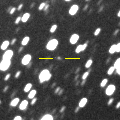
|
Now it is 17.4 mag (Mar. 6, A. Diepvens). Fading slowly. It will be fainter than 18 mag in May. In the Northern Hemisphere, it stays observable in good condition. It locates somewhat low in the Southern Hemisphere.
Date(TT) R.A. (2000) Decl. Delta r Elong. m1 Best Time(A, h)
Mar. 23 7 1.94 22 54.6 1.999 2.408 101 17.5 19:38 ( 39, 75)
Mar. 30 7 9.13 23 15.2 2.078 2.403 96 17.6 19:45 ( 56, 71)
|
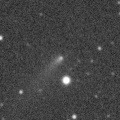
|
It brightened up to 14.9 mag in last eabrly summer (July 13, 2023, Taras Prystavski). Now it is 19.9 mag (Mar. 13, Toshihiko Ikemura, Hirohisa Sato). Fading gradually. It will be fainter than 18 mag in April. In the Northern Hemisphere, it stays observable in good condition. It stays extremely low in the Southern Hemisphere.
Date(TT) R.A. (2000) Decl. Delta r Elong. m1 Best Time(A, h)
Mar. 23 13 37.11 36 21.8 2.245 3.055 137 17.6 1:36 (180, 89)
Mar. 30 13 17.87 39 12.2 2.315 3.111 135 17.7 0:49 (180, 86)
|
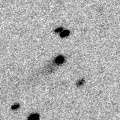
|
Now it is 17.4 mag (Mar. 6, ATLAS-MLO, Mauna Loa). It stays 18 mag for a while. It stays observable in good condition.
Date(TT) R.A. (2000) Decl. Delta r Elong. m1 Best Time(A, h)
Mar. 23 11 51.99 20 29.4 8.575 9.507 158 17.6 23:46 ( 0, 75)
Mar. 30 11 47.52 20 54.5 8.623 9.522 152 17.6 23:14 ( 0, 76)
|

|
Now it is 17.7 mag (Jan. 9, Toshihiko Ikemura, Hirohisa Sato). It stays 18 mag for a while. In the Northern Hemisphere, it will be getting higher gradually. In the Southern Hemisphere, it is not observable now, but it will appear in May.
Date(TT) R.A. (2000) Decl. Delta r Elong. m1 Best Time(A, h)
Mar. 23 22 48.37 37 53.9 4.899 4.202 41 17.7 4:34 (236, 19)
Mar. 30 22 49.67 38 23.7 4.889 4.202 42 17.7 4:24 (237, 22)
|

|
It will brighten up to 16 mag in summer. Brightening slowly. It stays extremely low in the Northern Hemisphere. But it will become high in summer. In the Southern Hemisphere, it stays observable in good condition.
Date(TT) R.A. (2000) Decl. Delta r Elong. m1 Best Time(A, h)
Mar. 23 21 5.23 -26 22.4 2.690 2.222 52 17.8 4:34 (304, 2)
Mar. 30 21 20.65 -25 39.6 2.631 2.222 55 17.7 4:24 (304, 3)
|
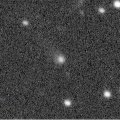
|
Now it is 17.9 mag (Mar. 16, ATLAS South Africa). It stays 18 mag for a while. In the Northern Hemisphere, it will never be observable after this. In the Southern Hemisphere, it stays observable in good condition.
Date(TT) R.A. (2000) Decl. Delta r Elong. m1 Best Time(A, h)
Mar. 23 4 18.44 -63 34.9 4.088 4.019 78 17.7 19:38 ( 21,-17)
Mar. 30 4 16.51 -62 22.5 4.127 4.043 78 17.8 19:45 ( 25,-19)
|
|
![]()
 C/2019 L3 ( ATLAS )
C/2019 L3 ( ATLAS ) C/2021 T4 ( Lemmon )
C/2021 T4 ( Lemmon ) C/2023 C2 ( ATLAS )
C/2023 C2 ( ATLAS ) 227P/Catalina-LINEAR
227P/Catalina-LINEAR C/2024 C4 ( ATLAS )
C/2024 C4 ( ATLAS ) 125P/Spacewatch
125P/Spacewatch C/2020 K1 ( PanSTARRS )
C/2020 K1 ( PanSTARRS ) 65P/Gunn
65P/Gunn C/2019 T4 ( ATLAS )
C/2019 T4 ( ATLAS ) C/2022 N2 ( PanSTARRS )
C/2022 N2 ( PanSTARRS ) C/2022 QE78 ( ATLAS )
C/2022 QE78 ( ATLAS ) C/2014 UN271 ( Bernardinelli-Bernstein )
C/2014 UN271 ( Bernardinelli-Bernstein ) C/2022 S4 ( Lemmon )
C/2022 S4 ( Lemmon ) 103P/Hartley 2
103P/Hartley 2 C/2022 T1 ( Lemmon )
C/2022 T1 ( Lemmon ) 130P/McNaught-Hughes
130P/McNaught-Hughes C/2021 Y1 ( ATLAS )
C/2021 Y1 ( ATLAS ) C/2023 P1 ( Nishimura )
C/2023 P1 ( Nishimura ) C/2024 A2 ( ATLAS )
C/2024 A2 ( ATLAS ) C/2023 F3 ( ATLAS )
C/2023 F3 ( ATLAS ) 30P/Reinmuth 1
30P/Reinmuth 1 C/2019 E3 ( ATLAS )
C/2019 E3 ( ATLAS ) 150P/LONEOS
150P/LONEOS C/2023 S3 ( Lemmon )
C/2023 S3 ( Lemmon ) C/2022 U3 ( Bok )
C/2022 U3 ( Bok ) C/2022 R6 ( PanSTARRS )
C/2022 R6 ( PanSTARRS ) 299P/Catalina-PanSTARRS
299P/Catalina-PanSTARRS C/2023 T3 ( Fuls )
C/2023 T3 ( Fuls ) C/2023 H5 ( Lemmon )
C/2023 H5 ( Lemmon ) C/2021 S4 ( Tsuchinshan )
C/2021 S4 ( Tsuchinshan ) C/2024 A1 ( ATLAS )
C/2024 A1 ( ATLAS ) 362P/(457175) 2008 GO98
362P/(457175) 2008 GO98 37P/Forbes
37P/Forbes 478P/2023 Y3 ( ATLAS )
478P/2023 Y3 ( ATLAS ) C/2023 K1 ( ATLAS )
C/2023 K1 ( ATLAS ) C/2020 F2 ( ATLAS )
C/2020 F2 ( ATLAS ) C/2022 U1 ( Leonard )
C/2022 U1 ( Leonard ) 89P/Russell 2
89P/Russell 2 C/2022 A3 ( Lemmon-ATLAS )
C/2022 A3 ( Lemmon-ATLAS )![]()























































